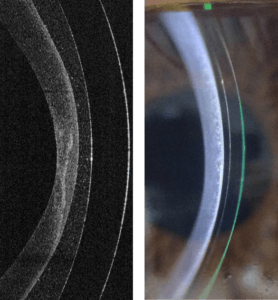
Optimizing Ocular Health with Onefit Scleral Lenses by Ledonna Buckner, FCLSA, NCLEM
The following article was featured in the GSLS Knowledge Center on Contact Lens Spectrum, following the 2017 Global Specialty Lens Symposium in Las Vegas. Read the full article here
With the reintroduction of scleral lenses, many benefits have been realized, but questions of oxygen delivery to the cornea have also been raised. The benefits to irregular corneas have been demonstrated with improved visual acuity and the treatment of ocular surface disease. The excellent comfort of scleral lenses, along with the ability to deliver crisp vision in a stable design, has led manufacturers and practitioners to expand this technology to the refractive correction of normal corneas. The long-term outcome of the use of scleral lenses on the normal cornea is unknown, but at Blanchard Contact Lenses, we have always known that “It’s All About Oxygen.” With this in mind, Blanchard developed the Onefi t™ Scleral Lens, utilizing a minimalist design and fitting philosophy — minimal lens mass and tear lens thickness to deliver optimal oxygenation to the cornea.
t™ Scleral Lens, utilizing a minimalist design and fitting philosophy — minimal lens mass and tear lens thickness to deliver optimal oxygenation to the cornea.
At the 2017 Global Specialty Lens Symposium meeting in Las Vegas, Langis Michaud, OD, MSc, FAAO (dipl), FSLS, FBCLA, presented theoretical data from many studies that modeled the predicted outcome of the oxygen transmissibility of scleral lenses. An in vivo study by Claude, Morency, Melillo, and Michaud confirmed the suggestion by theoretical models that we should limit the thickness of the lens, as well as the thickness of the tear film, to allow normal corneal physiological responses and to avoid hypoxia.
While it is important to strive to meet the Holden and Mertz (Dk/t of 24), Harvitt and Bonanno (Dk/t of 35) criteria when fitting normal corneas, John Gelles, OD, FIAO, FCLSA, presented clinical data in the form of a case report from his pilot study, evidencing the relief of corneal edema using the minimalist fitting approach of Onefit™ lenses on corneal transplant patients. The risk-benefit ratio must be carefully considered when fitting these highly compromised corneas with scleral lenses to avoid irreversible complications, such as corneal vascularization or endothelial pleomorphism or polymegathism.


